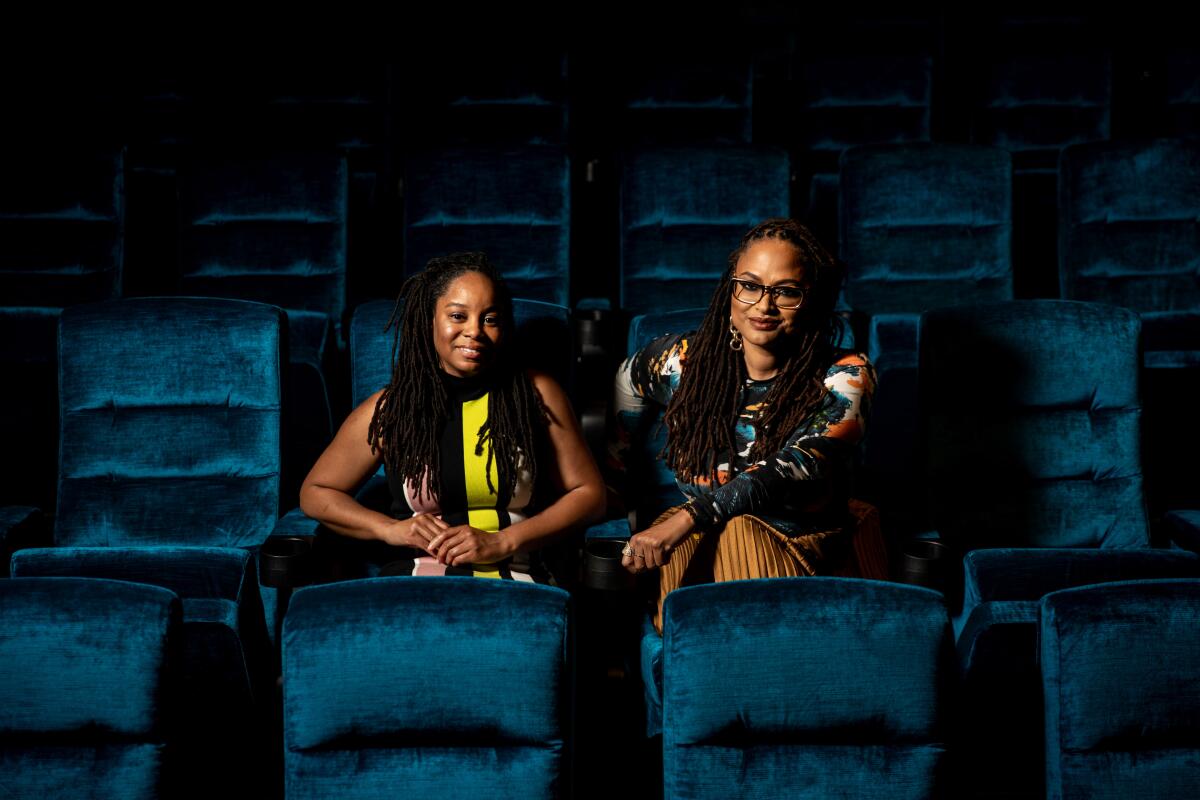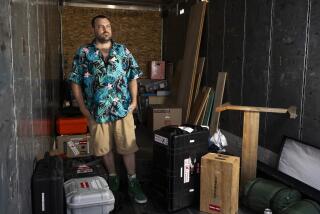Ava DuVernay’s Array is a place for women and filmmakers of color in L.A.

- Share via
The first thing that stands out about Ava DuVernay’s new movie theater at her Historic Filipinotown headquarters is the color of the seats. Rather than the classic burgundy of old-school movie houses, they shimmer with bright turquoise, resembling something out of “A Wrinkle in Time,” the Disney film she directed.
“You walk in and the color hits you,” DuVernay says, seated in the front row of the 50-seat auditorium, built for free public events, as well as private screenings. “We wanted to be a little rebellious. Look, we’re black ladies. This is our screening room. We want hot pink chairs? We’re going to have them.”
The “When They See Us” director’s rebellious streak will be on display in the coming weeks at the new theater, which DuVernay completed in June. The Amanda Theater, named for the filmmaker’s late aunt Denise Amanda Sexton, is hosting the inaugural Array 360 screening series to highlight movies made by and featuring women and people of color. Featured films include eight works by the late “Boyz n the Hood” director John Singleton and two by French New Wave icon Agnès Varda.
The series, curated by Programming Director Mercedes Cooper, is just one part of a growing assortment of ventures DuVernay, 47, has built on her 14,000-square-foot, three-building compound on Glendale Boulevard between Echo Park and downtown Los Angeles. The new theater, which sits inside a 7,500-square-foot bowstring truss structure, represents the final piece of the puzzle of DuVernay’s Array campus, which opened early last year.
Part of the goal of the campus is to create a physical space where women and artists of color can promote and showcase their work for years to come.
DuVernay’s efforts could provide a boost for filmmakers like Garrett Bradley, 33, a New Orleans-based director whom DuVernay hired to make an episode of TV series “Queen Sugar.” Bradley will visit the location in October to screen her short films “Alone” and “America” as part of the series.
Establishing this campus, which will embody the change Ava is working for, will ensure a radical type of institutional support for generations to come.
— Garrett Bradley
“Historically, having physical space has been monumental to ensuring that a community can survive,” said Bradley in a phone interview. “Establishing this campus, which will embody the change Ava is working for, will ensure a radical type of institutional support for generations to come.”
DuVernay’s collective, as she calls it, consists of three separate entities, all of which call Array Creative Campus home. The newest is Array Alliance, the nonprofit organization she founded last year to fund programming and educational events promoting social impact and boosting women and nonwhite filmmakers. Array Alliance is funding the new screening series at the campus. The nonprofit aims to raise at least $2 million annually for screenings, events and other activities, according to state records.
The campus also includes Array Releasing, a for-profit distribution company DuVernay launched nine years ago to acquire and release independent movies that might not otherwise have a major platform. Its releases include the visually striking 2018 drama, “The Burial of Kojo,” a movie from Ghana that was shown in select domestic theaters and on Netflix.
Then there is DuVernay’s privately held production company, Array Filmworks, which is responsible for acclaimed shows including Netflix’s “When They See Us” and Oprah Winfrey Network’s “Queen Sugar,” as well as the Emmy-winning Netflix documentary feature “13th.”
Though each unit does something different, DuVernay says they share an overarching mission to push for social justice and to challenge the entrenched Hollywood systems.
“The idea was to be disruptive in every system within which artists, especially artists of color and women, have to work in this industry,” she said. “Every system has roadblocks for people like us, whether it is in acquisition, production, distribution, exhibition, marketing, crewing up.... So what we were looking to do was disrupt those systems so that we create normalcy and momentum.”

A graduate of UCLA, DuVernay learned the business by working as a film marketer and entertainment industry publicist, promoting such movies as “The Help” and “Collateral.” Inspired by working with prominent filmmakers Michael Mann, Clint Eastwood and Steven Spielberg, DuVernay made her directorial debut in 2008 with the hip-hop documentary “This Is the Life.” She has often drawn upon her experiences growing up in Compton.
Array’s footprint has grown rapidly in the year and a half since the company moved to its new location from a small office in Sherman Oaks. Altogether, her ventures employ 18 people full-time, up from just four in 2018 (not counting writing and production staffs). Eight work for the nonprofit, while the production company and distribution firm each employ five.
Ford Foundation President Darren Walker first encouraged DuVernay to launch a charity dedicated to social impact goals in 2016. He paid for a consultant to guide her through the process, which she initially found intimidating, she said. The organization seeks to raise money from high-net-worth donors and foundations, according to public founding documents.
“I was scared of the nonprofit world,” said the publicist-turned-filmmaker. “I didn’t know anything about it.”
Establishing the Array campus has also allowed DuVernay to pursue her larger ambitions with more creative and financial freedom. Previously, DuVernay had to rent space for her writers to work on shows. While writing Season 2 of “Queen Sugar,” the scribes worked out of a building owned by Steve Carell in Sherman Oaks. DuVernay said she was inspired by J.J. Abrams and Katie McGrath’s Bad Robot headquarters in Santa Monica.
“All his dreams happen in that space,” she said of Abrams’ Bad Robot facilities. “I thought, ‘Golly, I would like to do a black woman version of this....’ We’ve been taught that the system is to take up space on a studio lot, right? That’s a part of your deal. You’re ballin’ if you’ve got an office on the lot, but you’re paying four times as much as you would if you take that money and bought something with it.”
Now, Array Creative Campus hosts the writing teams for DuVernay’s shows including “Cherish the Day,” an anthology series she’s making for OWN. It also boasts the editing bays for “Queen Sugar” and “When They See Us,” the four-part drama about the so-called Central Park Five teenagers who were wrongly convicted of a brutal 1989 assault on a Central Park jogger. (“When They See Us” star Jharrel Jerome recently won the Emmy for lead actor in a limited series.) When DuVernay started writing the in-the-works DC Comics movie “The New Gods,” she and co-writer Tom King spent each day working in a different part of the campus for maximum creativity, she said.

Historic Filipinotown was an ideal location because of its proximity to creative and business hubs including downtown, Hollywood and Silver Lake, as well as more black and brown areas such as East L.A. and South L.A. The surrounding area is a growing destination for prolific entertainment firms, including the production companies run by Jason Blum (“Get Out”), Dan Lin (“It”) and Margot Robbie (“I, Tonya”).
In honor of the neighborhood, Array commissioned an outdoor mural by Filipina-American artist Allison “Hueman” Torneros. One day of the Array 360 screening series has been labeled a “Filipinx Film Fiesta,” showcasing four films made by Filipino filmmakers. Cooper, Array’s programming director, said showcasing Filipino filmmakers was a key priority, though it was a challenging one.
“That was an area I had to realize, diving in, actually, I don’t know a lot about Filipino films,” said Cooper, 42, who served as Array’s marketing head for years before taking on her new job. “That was very humbling for me, realizing, I might be a film nerd, but I don’t know as much as perhaps I should.”

The free six-week series kicked off last weekend with works by cinematic luminaries such as Barbara Loden and Euzhan Palcy. Director Michael Mann is expected to give a Q&A at an Oct. 12 screening of his 2004 film “Collateral.”
Cooper also gave the series a personal touch. For one screening, she chose “Hour of the Star,” a female-directed Brazilian drama she fondly remembered first seeing during an undergraduate elective class while attending University of Maryland at College Park (she still owns a VHS copy).
For DuVernay, the screening series is a significant step because it marks the first time the Array campus has opened itself up to the public.
“Array 360 is the opening of the door and the first invitation for people in the community to come in,” DuVernay said. “It is the entry for films to be shown from other community stakeholders, where you don’t have to beg, borrow, plead or have a big studio to show your work.”
More to Read
Inside the business of entertainment
The Wide Shot brings you news, analysis and insights on everything from streaming wars to production — and what it all means for the future.
You may occasionally receive promotional content from the Los Angeles Times.











